By Jeffrey A. Rendall, Photos by Kevin Gaydosh
EAST STROUDSBURG, PA – Everyone knows some things get off to a rocky start, but this was ridiculous.
In pinpointing the one aspect of building Great Bear Golf Club (in the Pocono Mountains of northeastern Pennsylvania) that sticks out the most in his mind, Dave Heatwole said it was dealing with the rock.
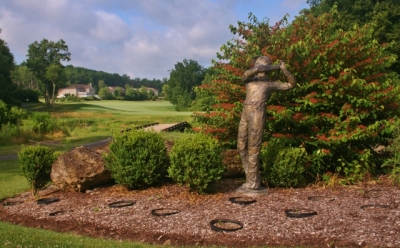 |
| The gardens around the Great Bear clubhouse get you in the mood for golf. In the background is the conclusion of the par five 18th hole. |
Heatwole should know, having had to deal with the hard stuff on a daily basis as Senior Design Associate for Jack Nicklaus in planning and constructing Great Bear. Upon opening (in 1997), Great Bear became the region’s only Jack Nicklaus signature course – but it was a monumental task just to reach that day.
“Great Bear was literally blasted out of rock,” Heatwole remembered. “We had so much material left from blasting that we had to find places to hold it – and that’s why you see rock on all the tee slopes. We also had to move the blasted rock to places where we could stack it and then maybe tie the soil to create a little more width for the playing areas. It was quite a job, let me tell you.”
Even the irrigation system had to be blasted in. Whereas you’d typically have a main line and a lateral line in a golf course irrigation system, Great Bear’s is a unique double-row arrangement that included the main line.
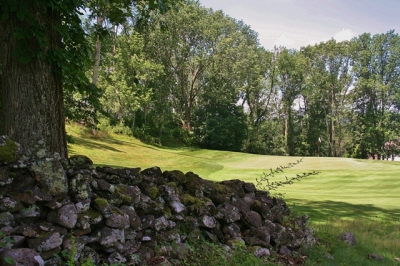 |
| Rock walls abound at Great Bear. Here, near the green of the par four 14th hole. |
Improvisation was the word. It’s the only thing you can do when you have that much rock.
Great Bear was the brainchild of a local developer and owner of a couple nearby hotels. This gentleman envisioned the course as the premier golf club in the Pocono Mountains. It just so happened he was paired with Jack Nicklaus one time in a Pro-am down in Florida. Conversation during the round led to striking a deal to have Jack come up and build the course.
They probably didn’t realize then just how much rock they would have to deal with, the land previously having been used for farming. The Keystone Farm occupied the northeastern portion of the property and the Hutchery Farm occupied the southwestern parcel (barns and outbuildings of both farms still stand on the property, preserving its rural quality).
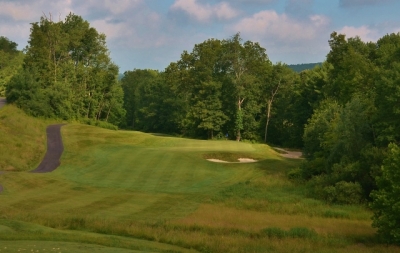 |
| Use the slope of the green to steer the ball towards the hole on the par three 2nd hole. |
The course was actually built by Jack’s own construction company, Paragon Golf. Because of the natural challenges involved, Great Bear cost over $10 million to build – with no shortcuts taken in terms of expense. More than $500,000 was spent on blasting alone.
Being that Great Bear is a Jack Nicklaus signature course, the Golden Bear himself was personally involved in all aspects of designing the layout, including giving his final okay on the greens.
The uniqueness of the land limited them in some ways, according to Heatwole, but it also offered opportunities. “For the most part, it was a heavily wooded site, so we tried to keep that quality -- not to over-clear it, which gives the layout a different kind of feel through the trees.”
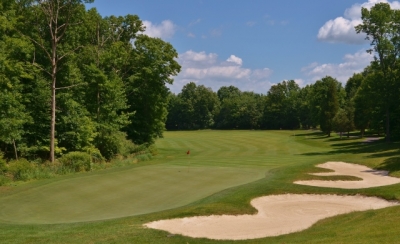 |
| Looking from behind the green of the par four 12th hole. |
“It’s not your typical modern golf course. I would say it’s almost a little more traditional, old-style minimalist in character. A lot of it had to do with just following the terrain that was there and routing a course into it that would flow through the topography and naturally puts some variety in the holes. In a course like that, probably because it was a little bit more narrow – there wasn’t really a need for as much bunkering.”
“There weren’t great expanses around the greens to justify adding a lot of bunkers – where if you’re going to miss the greens, there isn’t a lot of excess space before you reach the trees.”
The limited corridor space was also due in part to a need to conserve topsoil. Heatwole said they made extraordinary attempts to preserve what they had on top of the rocks, and they also took whatever they could from the road-building projects in the surrounding residential neighborhood.
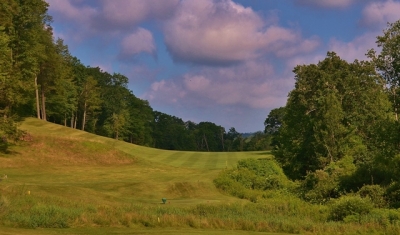 |
| The long and challenging par four 3rd hole is the #1 handicap hole at Great Bear. |
What did it all add up to?
A beautiful golf course on a pristine piece of land, accented by rock outcroppings and lush forest. But it also brought some playing challenges that go along with a layout that is tight in spots.
And a few blind shots. Great Bear was originally intended to be a private club and Heatwole indicated you can make some allowances in design for a course that was meant to be played continually by members. For first timers, it’s a bit of a struggle to pick the right lines on certain holes.
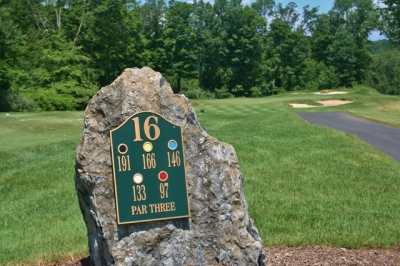 |
| The par three 16th is rated the easiest hole at Great Bear. |
Those playability issues are being addressed by Great Bear’s new ownership. The good folks at the nearby Shawnee Inn purchased the facility a few years ago and have made some changes to allow Great Bear to continue to service members, Inn guests and daily fee players.
The course was shut down for a period of time, all the while being maintained by Superintendent Keith Snyder and golf professional Vince Yanovitch, who have both been at Great Bear since its opening.
Heatwole said he was surprised that Great Bear was closed when he visited a while back, but was very complimentary of Snyder and his crew’s efforts in keeping the course in good shape for its eventual return (the only alterations to the layout over time have been adding some new teeing areas on par threes).
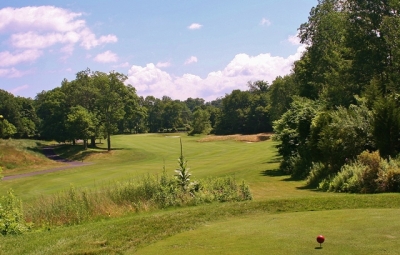 |
| The par four 9th hole features a tight dogleg from the back tees, but is straight-on from the forward set. |
One slight change after the course re-opened was the addition of some “natural” areas that were allowed to remain. It narrows the course a little in some spots that used to be maintained – but Snyder will cut them back if needed.
When I say “narrow,” don’t get the impression it’s tight everywhere. There are the aforementioned blind shots, but that’s only due to the rolling lay of the land. The course features over 40 acres of turf – which considering the abundant natural areas and no parallel holes, is quite a lot.
Snyder maintains the rough at 3”, which allows you to find the ball easily. We played the course in July, so the rough was very thick, making it difficult to advance the ball very far. As would be expected, the course could be amped up to host championship events. Call it sharpening Great Bear’s teeth.
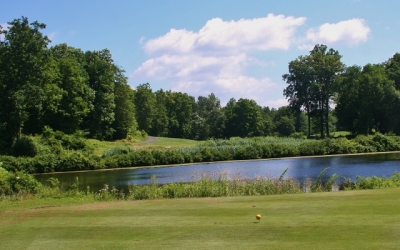 |
| The tee shot on the par four 10th hole is quite intimidating. |
Head Professional Chris Wegner explains what makes the course challenging: “The greens. The golf course offers wide landing areas and lots of risk-reward opportunities, but the true challenge lies in reading the greens. Lots of humps and swales leave you with very interesting and challenging putts, putting a premium on placement of approach shots.”
Wegner’s right – bring your putting skills with you to Great Bear, or you’re in for a long day.
One player-friendly aspect of the course is the inclusion of a fifth par three (par 71). Par 71’s usually take away a par five, but it’s nice to have one less par four instead at Great Bear. Tee distances range from 4,949 yards to 7,025.
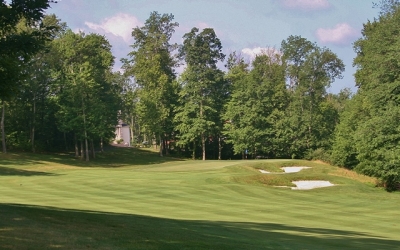 |
| The par five 4th hole is one that will take a few times playing it to understand how to attack it properly. |
There also aren’t any uphill holes, which is surprising considering the uneven property – everything’s at eye-level or downhill.
Wegner describes several of the highlight holes:
“The 440-yard, par four third is our most difficult hole and stays in the memory of the golfer visiting Great Bear for the first time. A drive that plays well uphill is needed here, but don’t let it go right because a pond runs along the length of the hole. A middle-to-long iron is needed for a downhill shot to a generous green protected by two front bunkers.
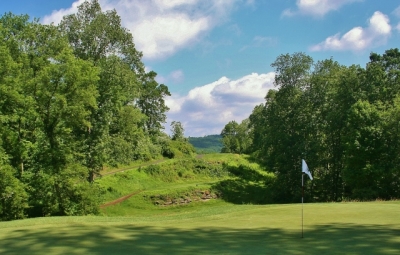 |
| The picturesque par three 7th is often mentioned as a signature hole. Here, you can see why. |
“The par three seventh is a 150-yard hole that is one of the prettier links and many visitors refer to it as the signature hole. It’s probably the easiest looking hole on the course, but looks can be deceiving. Your shot is all carry over a finger of wetlands that sit in the deep valley to a small green guarded by a bunker front right.
“On the back nine, number ten is a medium length par 4 that offers a truly picturesque start to the backside. The tee shot plays over the existing ponds to the elevated fairway. A fairly straight tee shot will be required as this hole is guarded by trees on both sides and the approach shot will likely require a medium iron. Finally, this hole has one of the most unique greens surrounds on the course, featuring a large rock outcropping just off the right side.
“Last but not least, the finishing hole offers the aggressive golfer a chance to go for the island green in two on this long par 5. Off the tee, the golfer must be wary of the bunker along the left side of the fairway and the bunker right. If these bunkers are played safely, one has a decision to lay up or go for the green surrounded by wetlands. The green also is protected by a front bunker. This closing hole has the classic heroic design. Many wagers and matches will be won and lost here.”
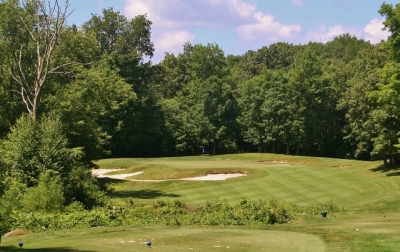 |
| The well-guarded par three 13th hole. |
No doubt. The eighteenth definitely got the best of us on the day we played.
With the beauty of the layout and its surroundings, you may wonder about walkability. You can hoof-it if you like at Great Bear, but with the course coming in at a little over 6.5 miles, be prepared for a trek.
As stated before, the course has no parallel or uphill holes, so there are some rather lengthy walks between tees that include a few steep climbs.
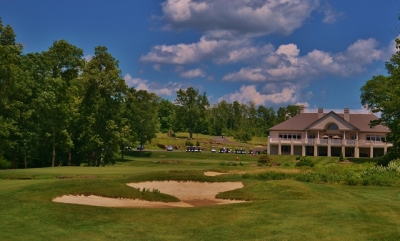 |
| Coming home on the par five 18th, you will be planning your next visit to Great Bear. |
“We do offer 9 hole cart fees for members to ride the front nine then walk the back nine, which is a little easier on the legs,” Wegner said.
The back nine is a fair amount flatter, and the Nicklaus group always makes their courses interesting and difficult – particularly from the back sets of tees. Great Bear has quite a bit less bite from the front sets, even earning a top 100 Best Women Friendly Golf courses ranking from Golf for Women magazine.
We’ll leave the last word to Wegner: “I want golfers to have had a memorable round. Each hole here at Great Bear is easy to remember and we want them wanting to come back for another 18. It’s a great member course as you can play all day and play over and over and never tire of the challenge.”
Definitely true – it’s never dull. Great Bear is rock n’ roll in the Poconos.
Click here to read more on the Shawnee Inn.
Click here to read about the Tillinghast-designed golf at the Shawnee Inn.
Details:
Great Bear Golf Club
One Great Bear Way
East Stroudsburg, PA 18302-8275
Phone: (570) 223-2000
FAX: (570) 223-8510
Web: www.GreatBearGC.com
Course Designer: Jack Nicklaus
Senior Design Associate: Dave Heatwole
Head Golf Professional: Chris Wegner, PGA
Superintendent: Keith Snyder
Tees/Yardage/Slope/Rating
Black 7025 139/73.4
Gold 6537 138/71.3
Blue 6105 133/69.7
White 5754 128/68.2 133/74.1 (W)
Red 4949 117/68.7
Rates:
Includes greens fee and carts. Practice facility use additional $10.
Non-Members:
M-Th: $95 until 1. Off season: $80. After 1 pm: $75/$65. Twilight: $45
Weekends/Holidays: $115 until 1. Off season: $95.
After 1 pm: $90/$75. Twilight: $65/$50
| Related Links | Comments on this article? | |
|
Maryland National Golf Club Hollow Creek Golf Club Rocky Gap Resort PB Dye Golf Club in Ijamsville Whiskey Creek Golf Club |
E-mail Jeff Rendall, Editor: jrendall@golftheunitedstates.com |












